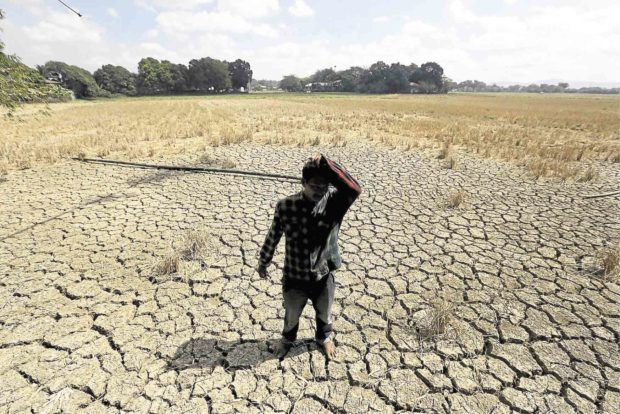Farmers’ losses mount as El Niño’s grip widens

BAKED AND BARREN All that toil came to naught for a farmer whose rice field in San Ildefonso, Bulacan province, has been reduced to a drought-scarred landscape. —RICHARD A. REYES
Carabaos and goats reportedly dying. Crops wilting and residents waking up at 2 a.m. to wait for water to flow from their faucets.
These are some of the effects of El Niño gripping a growing number of provinces and cities across the country even before the dry season is officially declared.
An initial P1.2 billion in damage to crops, mostly rice and corn, was reported in nine provinces and three cities in the Visayas and Mindanao, according to dispatches reaching the Inquirer as of Tuesday.
One of the worst hit is Cotabato, which said it had so far sustained P362 million in damage to rice and P269 million in damage to corn.
In Occidental Mindoro, local governments have resorted to digging up riverbeds for water to irrigate farms reeling from the heat.
Some 3,000 hectares of farmland have been affected by the dry spell, Tony Gerundio, Department of Agriculture director in Mimaropa, said on Tuesday.
Gerundio said another 400 hectares of rice and other crops had dried up and were already “beyond recovery.”
Lower water table
In Pangasinan province, Oftociano Manalo, a director of the Federation of Irrigators’ Associations, said his 12.2-meter deep tube well could no longer pump water to his farm because the aquifer had gone deeper.
Manalo said he had to give up his corn farm because of lack of water.
Crop damage in Cotabato climbed to P670.89 million, prompting the disaster body to recommend cloud seeding to save the remaining crops.
Remedios Hernandez, acting provincial agriculturist, said rice and corn fields were devastated due to low rainfall over the past three months.
Cattle deaths
The provincial veterinary office is verifying reports of carabao and goat deaths because of intense heat.
In Kidapawan City, the Disaster Risk Reduction and Management Council called for the declaration of a state of calamity as crop damage had reached P53 million.
Marisa Aton, acting city agriculturist, said the villages of Patadon, Malinan and Maceboleg had already declared a state of calamity in their jurisdictions.
The dry spell has so far destroyed P185.1 million worth of rice and P6 million worth of corn in Occidental Mindoro.
Maguindanao incurred losses of P46.8 million for rice and P54 million for corn.
The Zamboanga Peninsula region—mainly Zamboanga del Sur but also Zamboang del Norte and Zamboanga City—lost P79.6 million worth of rice and P3 million worth of corn.
Also affected were Davao del Sur (P55 million in lost crops), Cotabato (P30 million) and Misamis Oriental (P7 million).
In Pagadian City, the Sangguniang Panlungsod declared a state of calamity on Tuesday after 40 of its 44 barangays reported P102 million in crop damage.
Other barangays also reported P23.4 million in damage to high-value commercial crops and to seaweed, affecting more than 1,000 farmers.
In Cauayan town, Negros Occidental, the dry spell damaged P6.1 million worth
of crops between January
and February, affecting 143 hectares and 253 farmers in seven barangays, according to provincial agriculturist Japhet Masculino.
Masculino said farmers from other localities had stopped planting rice due to the dry spell.
In Iloilo City, Rene B. Famoso, agriculture field operations division chief for Western Visayas, urged rice farmers to plant drought-resilient crops such as onion and garlic.
In Laguna, provincial agriculturist Marlon Tobias said 11.8 hectares of farmland in Calamba City had dried up.
Minimal impact
The Department of Agriculture said El Niño had so far affected 13,679 hectares and destroyed 22,918 tons of crops as of Tuesday.
Agriculture Secretary Emmanuel Piñol said the impact of the losses on national output was minimal as these accounted for just 1 percent of the agriculture sector.
While farms are drying up in other parts of the country, Zamboanga City is facing a water shortage.
Of the 62,000 households in the city, more than half were getting water intermittently, said Edgar Banos, information officer of the Zamboanga City Water District.
Gertrudes Macapili, a mother of four and a schoolteacher, said water rationing was making her unproductive.
Waking up at 2 a.m.
“I have to wake up at 2 a.m. just to wait for our faucet to start flowing. We could hardly fill a liter of water in three minutes. I have to report to school very late, because we are only given water from 3 a.m. to 10 a.m.,” Macapili said.
Macapili noted that the water shortage had been recurring every year “[b]ut every year, it is getting worse,” she said.
Primacita Basilio, who has a disability, said water was available only between 3 a.m. and 11 a.m.” in Tetuan.
“I am a mother who makes a living selling cooked meals. It’s really miserable every day to wake up early just to store water,” Basilio said. —REPORTS FROM RONNEL W. DOMINGO IN MANILA; ARMAND GALANG AND GABRIEL CARDINOZA, INQUIRER NORTHERN LUZON; MARICAR CINCO, INQUIRER SOUTHERN LUZON; HAZEL P. VILLA, ADOR VINCENT MAYOL AND CARLA P. GOMEZ, INQUIRER VISAYAS; JULIE ALIPALA, WILLIAMOR MAGBANUA AND LEAH AGONOY, INQUIRER MINDANAO














